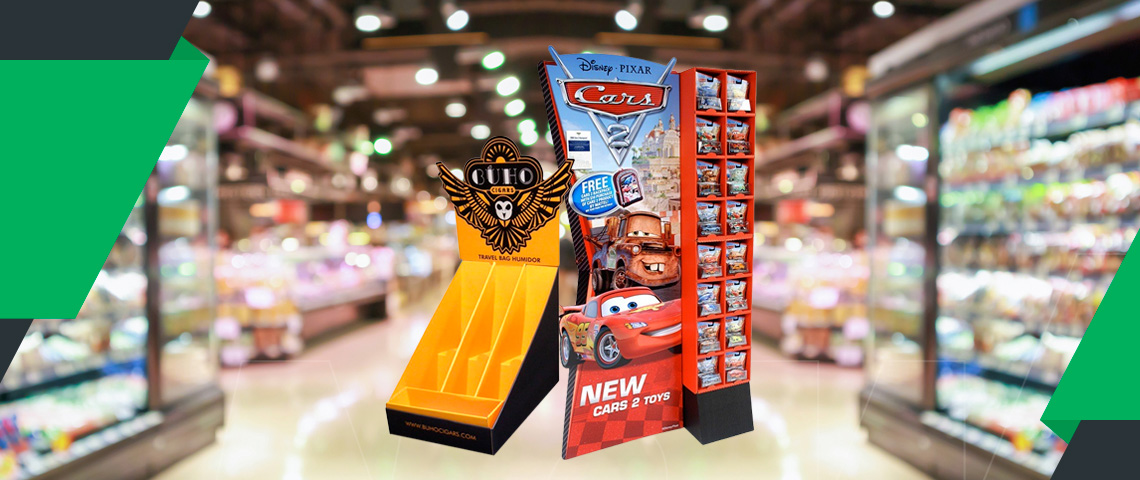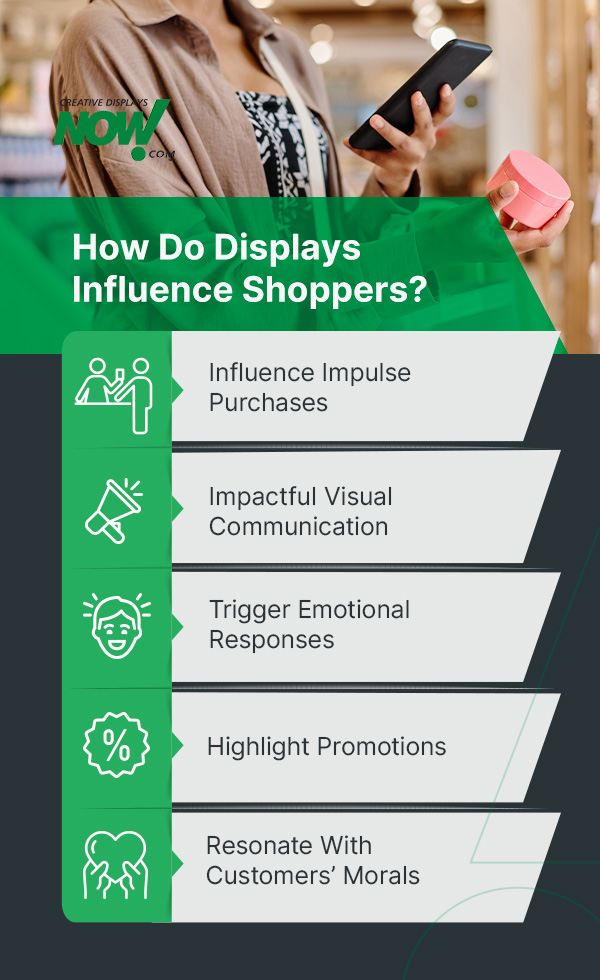Do Custom Displays Increase Sales?
Custom displays are valuable marketing tools companies use to boost sales and increase brand awareness. They showcase your products in an eye-catching display so shoppers can see and access them easily. You can reach your marketing objectives using various types of customizable retail displays. Brands that sell consumer packaged goods (CPG) can use custom displays to drive sales, build their reputation and grow their customer base.
How Do Displays Increase Sales?
Place custom visual displays in high-traffic areas where shoppers are more likely to notice and purchase your products. In-store display marketing promotes your merchandise and helps customers make buying decisions. Marketers often use retail displays to increase sales for:
- Expand your customer base: POP displays attract attention, so shoppers will stop and check out your merchandise. Retail displays entice new customers and keep existing customers coming back for more. If you’re trying to reach a specific market, you can use POP displays to target that demographic.
- Make a great first impression: Whether you’re promoting an existing product or introducing a new one, POP displays create a memorable first impression. Even if the shopper doesn’t purchase, the display helps spread brand awareness and a positive reputation.
- Maintain a competitive edge: You can reach the customer before anyone else by placing a custom display in a convenient, high-traffic area. For example, if a POP display of tortilla chips is placed near the salsa, shoppers may choose that product before making it to the chip aisle.
- Educate potential buyers: POP displays also function as full-time sales associates. They provide valuable information to help consumers make purchasing decisions and answer common questions, so shoppers are more likely to buy your product.
- Enhance the shopping experience: It’s important to create a positive shopping experience to keep consumers coming back for more. POP displays help create the exciting and interactive experience that shoppers crave. They’re highly customizable so you can create unique experiences for customers.
Is In-Store Advertising Effective?
Although e-commerce has increased significantly over the last decade, in-store advertising is still vital. In-store advertising has an undeniable influence. One study found that 82% of shoppers make in-store purchasing decisions, and 62% of those purchases were impulse buys. Here are the top reasons why in-store advertising is effective:
- Increases revenue quicker than other methods: In-store advertising is one of the best investments for a speedy increase in revenue. It lets companies market products directly, pulling in a larger range of potential customers and encouraging them to interact with the brand and make a purchase.
- Provides a cost-effective advertising option: Some forms of advertising, like television ads, can be incredibly expensive. Studies show that while TV ads may cause a spike in online browsing activity while they are airing, it doesn’t typically lead to any long-lasting engagement. In-store advertising is a cost-effective option that allows you to speak directly to an audience in a store where it’s easier to make a purchase.
- Captivates the target audience: In-store advertising methods like retail displays draw attention from shoppers. They provide customers with a more convenient way to shop by offering easy-to-access information and engagement.
- Increases product and brand visibility: In-store advertising helps customers engage with a brand and build positive connections. Methods like retail displays can be placed strategically to increase visibility and encourage impulse buys.
Why Your Products Need POP Displays
POP stands for point-of-purchase in marketing and these displays can benefit your business in many ways. They’re placed in high-traffic areas and boost shoppers’ chances of noticing a product or brand. Showcasing your products helps establish brand awareness and increase sales.
POP displays make products stand out from competitor goods. Shoppers may be scanning through the aisles quickly, and a POP display can help them notice your products. It positions information in the consumer’s direct line of sight, improving the likelihood of them making a purchase.
These displays help boost sales by grabbing consumers’ attention and communicating your brand’s message. Creative graphics and designs placed in high-traffic areas enhance brand recognition and push sales, increasing your return on investment (ROI).
How Do Displays Influence Shoppers?
Retail displays do more than increase revenue for companies — they also create a lasting effect for customers. When shoppers look at a display or pick a product, they unconsciously interact with and form a positive experience of that brand. Here are the ways that displays increase sales by influencing shoppers:
Influence Impulse Purchases
Retail displays, especially POPs have the capability to trigger impulse buys. Using visual prompts and eye-catching designs can make shoppers excited to try the product. This works especially well for goods that have unique visual appeal.
The location of the retail display also affects impulse purchases. Displays that are in the line of sight for shoppers grab more attention, which encourages impulse buying.
Impactful Visual Communication
POP displays are what companies use to create impactful visual messaging using graphics, images, design and copy to communicate with the audience. They elicit emotional responses and leave a lasting impression with simple yet inspiring storytelling and imagery.
Using strategically placed messaging and engaging visuals can communicate a brand message in an instant. Colors and lighting help influence perceptions. For example, in-store displays that are black may convey a message of sophistication and elegance, while green may express eco-friendly and sustainable practices.
Trigger Emotional Responses
How you design your POP display, the colors you use and the messaging you convey all evoke emotional responses that influence a purchase. The in-store display meaning creates a connection with your audience and provides a memorable shopping experience.
You can trigger an emotional response using different colors or through effective storytelling. For example, red may create a sense of urgency, encouraging your audience to purchase impulsively. A compelling narrative in your messaging can tug on customers’ heartstrings. For example, depicting a happy family enjoying the product can influence them to feel like it’ll make their family happy if they buy it.
Highlight Promotions
Product displays in a retail store can influence purchases by helping you highlight a promotion or through cross-merchandising. These strategies create a sense of urgency, present an opportunity to save money or align your product with other complementary ones.
By using a POP display, you can show customers there’s an ongoing promotion and can help it along with colors, imagery and messaging. These elements showcase the benefits quickly and enthusiastically, encouraging a sale.
Where you place your product and POP display also influences purchases. Cross-merchandising is a common merchandise display idea that involves positioning displays near complimentary items. For example, placing mini marshmallows next to hot chocolate can tempt customers to buy both.
Resonate With Customers’ Morals
Effective retail displays resonate with the target audience. Value marketing is an increasingly popular product display strategy that works by matching the display design to the audience’s values. For example, if the target market is environmentally conscious, using sustainable materials to create displays shows customers that the brand shares their values.
Value marketing is an excellent way to speak to a target audience and increase brand loyalty. Here’s how to achieve it:
- Outline the company’s core values.
- Identify the audience’s core values.
- Align the company’s content with the audience’s core values.
FAQs About Retail Displays
Here are some commonly asked questions about retail displays to learn more about this marketing technique:
Does Personalization Increase Sales?
Yes. Personalization can dramatically increase sales and improve customer retention. One survey found that 80% of consumers prefer and even expect personalized experiences. Retail displays personalized for a specific target audience resonate more with shoppers and encourage long-term purchases.
How Effective Are Point-of-Purchase Displays?
POP displays are highly effective at drawing customers’ attention and pushing sales. They are especially important for encouraging impulse buys because they draw immediate attention.
How Does the Display Enhance Your Sales?
Retail displays enhance sales by influencing shopper behavior and incentivizing purchases. They evoke emotions and share messages that speak to shoppers and encourage them to try a product.
How Effective Are In-Store Displays?
In-store display marketing effectively influences shoppers’ purchasing decisions and spreads brand awareness. The location of the display influences effectiveness. One study found that shelf displays are most effective for brand choice purchases, and front-end cap displays had the biggest success with category purchases.
Get Retail Displays From Creative Displays Now
Creative Displays Now has spent over 60 years in the display and packaging business. We build temporary retail displays that boost product visibility and brand loyalty. Each temporary display is made of sustainable corrugated cardboard, allowing companies to change their in-store advertising while reducing environmental impact conveniently.
With our decades of experience, we know what brings results and which display styles suit major retailers. Do you want retail displays that resonate with your audience, boost sales and increase brand engagement?
Contact us for temporary retail displays that bring results.
Find Resources for Custom Displays
In this guide, you’ll learn all about custom POP displays and how to use them. We’ll review the different types of fixtures, their benefits and POP strategies that make the biggest impact. If you want to learn more about point-of-purchase displays and visual merchandising, explore our online guides and resources. You’ll find information about the CPG industry, retail customers and other valuable insights from a lead POP display designer and manufacturer.


